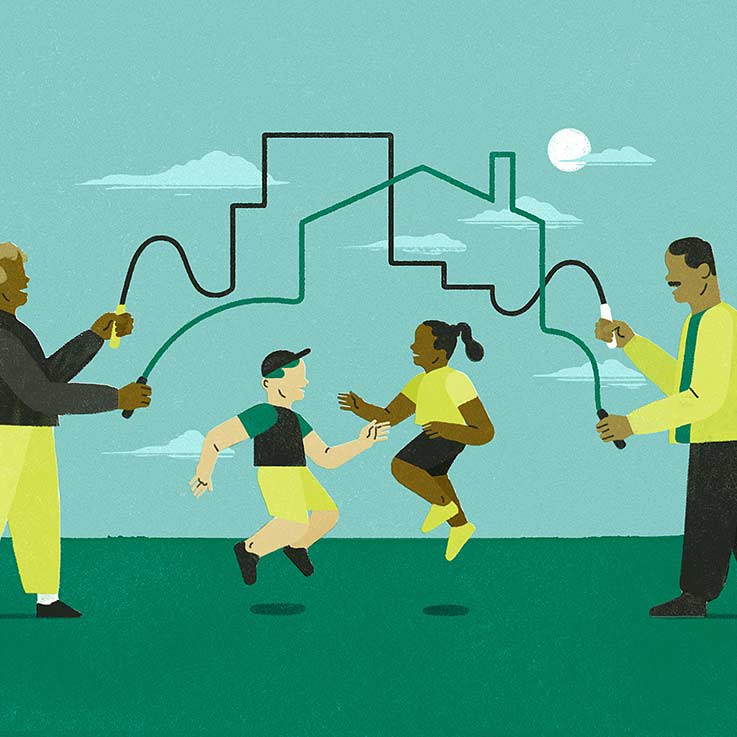
Scaling Community Finance to Fill a Growing Market Gap
Scaling Community Finance to Fill a Growing Market Gap
New public awareness of how the traditional financial system fails small businesses creates an opportunity to build models that connect entrepreneurs with the capital they need to recover, grow, and thrive—and that drive a more equitable and inclusive economy.
By Beth Bafford & Patrick Davis Jun. 23, 2021
When the COVID-19 pandemic hit, the US federal government assumed that banks were the best way to distribute billions of dollars of relief to small businesses. But this unplanned national experiment—the Paycheck Protection Program (PPP)—showed just how disconnected millions of people and small businesses are from the banking system.
We should have seen it coming. Banks have been moving away from local communities for a long time. In the years since the Great Recession, 389 banks have failed and more than 6,000 bank branches have closed. Small business lending in most US counties never rebounded; in 2017, it was roughly half the level of 2004. And since 1997, community banks’ share of loans under $100,000 has declined from 82 to 29 percent, leaving a gaping hole in the credit market for the smallest businesses. These gaps are even more acute in distressed communities. A nationwide study from 2011-2015 by the Urban Institute found that US communities with poverty rates greater than 20 percent received less than half the investment of other communities.
But crisis reveals character, and over the last year, community development financial institutions (CDFIs) have been stepping up to meet the moment. CDFIs are community-based, mission-driven lenders. The Treasury Department mandates that they work in low- to moderate-income communities and/or communities with structural barriers to credit access (such as in native and rural communities, and communities of color). As such, they are uniquely positioned to drive financial inclusion and more equitable economic growth, and directly address systemic racial and gender wealth and income gaps by reaching diverse communities.
After witnessing the unequal distribution of PPP funds through banks, the government has increasingly turned to CDFIs to deliver relief loans to hard-to-reach small business owners. But while this has highlighted the potential of CDFIs to reach those most in need, it has also highlighted the challenges that keep them from effectively addressing financial inclusion at scale.
Limitations to Scale
There are currently more than 1,100 certified CDFIs in the United States. About half are non-depository loan funds, and each originates loans in its own way. This is the strength of community finance: Products are flexible and reflect the nuanced needs of local markets. However, that same lack of standardization also limits the sector’s ability to scale by accessing more traditional market mechanisms like securitizations and an active secondary market.
Most CDFIs also lend from their balance sheet. Whereas a traditional bank may make a loan, and then sell that loan to another lender or investor to free up money for another loan, CDFIs hold the loans on their balance sheet, which have high capital requirements. In other words, CDFIs need a lot of equity to support their debt.
This combination of non-standard products and equity requirements constrains CDFIs’ ability to grow their supply of capital in moments when demand drastically increases. In the meantime, commercial online lenders and payment processors (some of them predatory) step in to fill the void, often with unaffordable terms. This creates a market with concentrated power, where small businesses have the most to lose.
Collaboration, Collaboration, Collaboration
At the end of March 2020, a group of investors and CDFI partners—including our organizations, Community Reinvestment Fund, USA (CRF) and Calvert Impact Capital—came together to figure out how to help small US businesses survive. We recognized that continued economic distress would likely widen the racial wealth gap and worsen outcomes for low-income and low-wealth communities. But we also saw a rare opportunity to reimagine community finance in ways that could both drive more equitable recovery, and build resilient and inclusive financial systems for decades to come.
So, around a virtual table, we laid out what CDFIs need most: direct capital, capacity, and technological support; efficient liquidity options to access affordable lending capital at scale; and an economic model to encourage long-term growth.
Each of our institutions brought different strengths. Our CDFI partners, for example, brought deep knowledge of their industry, as well as unbanked, small-business clients for which they could design standardized-but-flexible loans that drew lessons from flaws in the initial PPP product design. CRF had the technical tools to support a central marketplace that could match demand with supply while providing the data infrastructure to facilitate cross-lender standardization. Calvert Impact Capital structured and arranged funding from philanthropic and institutional investors to leverage public subsidy. And the Local Initiatives Support Organization (LISC), leveraged its fund management services to administer and manage diverse asset pools.
Growth and Sustainability: A New Model
Together, we designed a holistic lending model that combined centralized and scaled resources (capital, technical tools, and expertise) with a localized distribution network (community-based lenders and local support organizations). Inspired by the Chicago Small Business Resiliency Fund—which launched in March 2020 as a partnership between the Chicago mayor’s office, Community Reinvestment Fund, and Allies for Community Business, as well as investors such as Goldman Sachs, the Catalyst Fund, and MacArthur Foundation—our model has three main components:
- A capital solution. The CDFIs needed to make and sell loans to get them off their books, so we created a loan purchase facility supported by public, philanthropic, and institutional dollars. This increases the power of available funds so that for every $1 of lending capacity, the CDFI can do $20 of new lending. This facility (the “fund”) purchases and administers the loans, creating a blended capital structure suitable for different investors with different objectives. While participating CDFIs can still offer non-standard loan products to support targeted needs in their communities, the availability of a standardized product and purchase vehicle supports quicker, more efficient lending.
- Technology to support customer experience and standardization. To further streamline CDFI loan offerings, we leveraged two technology platforms: Connect2Capital and SPARK. These platforms provide a modern, technology-enabled customer experience for small-businesses (businesses can use a cell phone to apply and get matched to the appropriate CDFI loan product within two minutes), and reduce search-and-acquisition costs for CDFIs by connecting them to a pre-qualified pipeline of matched applicants. The platforms also enable better data protocols that, when combined with machine-learning algorithms, help CDFIs and investors gain improved data insight. Good data on performance is important for scale, because it starts to open doors for products and market mechanisms to attract more-significant institutional capital
- High-touch business support. The third prong of our model is technical assistance. CDFIs have varying capacities to provide direct services, so it was important to build a network of support around them. To support small business owners directly, we worked with our public-sector partners to connect and fund a broad network of local, trusted, technical-assistance providers to guide businesses through the local application process and navigate other resources available to them.
Since community finance is inherently local, we initially tested this “COVID-19 Response Vehicle” in partnership with Empire State Development and Homes and Community Renewal in New York State. Together with our CDFI and state partners, we designed the $100 million New York Forward Loan Fund—supported by investors like the Ford Foundation and Wells Fargo—to lend to small businesses, nonprofits, and small landlords. Taking lessons from Chicago and New York, we then structured the California Rebuilding Fund, designed in coordination with the California Small Enterprise Taskforce and the Governor’s Task Force of Business and Jobs Recovery. The fund launched in late 2020 with 12 participating CDFIs and Kiva, seeded by California’s Infrastructure and Economic Development Bank (IBank). Most recently, CDFIs in the South collaborated to offer a program across 15 states, an effort called the Southern Opportunity and Resilience Fund (SOAR), and efforts are underway to develop a similar program in Washington State.
In total, more than 30 CDFI loan funds are engaged across these programs. Importantly, each program was developed with and for a coalition of community lenders with deep local experience and expertise.
Reaching the Smallest, Un-Banked Businesses
Thus far, the results are promising. Through these programs and partners, we are reaching businesses that typically lack access to affordable credit. To date across programs, 90 percent of funded businesses have 10 or fewer employees; 88 percent have annual gross revenues of $1 million or less, while the average loan size is $39,600; 70 percent are owned by a woman and/or a Black, Indigenous, or person of color; and 51 percent are located in low- or moderate-income communities. We have catalyzed investment from more than 50 financial institutions and foundations that have jointly committed more than $300 million to new lending during a period when many have dramatically pulled back from small-business credit.
Early indications of performance show that participating business owners have retooled and survived, due in part to their ability to access credit. Earth Angel, a Brooklyn-based, women-owned business that provides environmental services to film productions, saw an immediate, 80 percent decline in revenue in April 2020. The founder quickly developed a new COVID-19 response package that merged production health and safety guidance with sustainability services. To help implement and scale its new services, TruFund Financial Services (a participating CDFI lender in the New York Forward Loan Fund) provided the company with a $72,000 loan. This helped Earth Angel not only retain its eight employees, but also create two new jobs. We hear stories of resilience like this across lending programs, across the United States. Small business owners need access to the same basic financial products as their larger counterparts, but because of their size, zip code, gender, or race, those products are often out of reach.
While it’s too early to draw conclusions on the ultimate performance of the loans, in the first nine months of lending, less than 1 percent of the portfolios of assets originated in New York and Chicago were delinquent. Perhaps most importantly, participating CDFIs have demonstrated their ability to stretch their capacity with the right resources. The four CDFIs making small business loans for the New York Forward Loan Fund saw a 7-fold increase in the number of loans they provided, and a 14-fold increase in their total lending volume between 2019 and 2020. This level of growth shows the real potential of CDFI loan funds to fill the gap created by the closure and consolidation of the banking system. It also suggests that they deserve more presence in national conversations about how we build an equitable financial system and economy going forward.
How to Rethink Community Finance
Designing and deploying this model taught us valuable lessons about how to think differently about the future of community finance:
- Collaborative design is essential. In an emergency like the pandemic, it is tempting to dive in to meet urgent needs. But institutions need to balance quick action with smart, inclusive design. Engaging with CDFIs, and taking time to understand their needs and those of their customers, enabled us to build a responsive, holistic model.
- Market structures should allow CDFIs to do what they do best. CDFIs are experts at providing hands-on support and access to affordable financial products, so scaling their work needs to preserve their relationship-driven model while taking other, non-core functions off their plates. In our programs, Calvert Impact Capital acts as a market intermediary and supports capital-raising by building both a pipeline of lenders for the loan facilities and the risk capital required to support new lending. CRF’s platform supports broad marketing and efficient customer acquisition. All of this frees up CDFIs to focus on increasing internal capacity to serve their communities now and in the future.
- We need to increase awareness of CDFIs and expand their capacity. For the last 20 years, the US banking system has shifted dramatically from relationship-based lending to rules-based lending, a formula that leaves many behind. Models like ours enable CDFIs to maintain, nurture, and build thousands of new relationships with business owners, but their ability to serve those relationships depends on their capacity to grow their systems and teams.
- Models must be sustainable and replicable. While we strive to meet urgent needs, we can’t forget the long game. The models we deploy now must move us forward, not simply act as stop-gaps before returning to “normal.” If we go back to pre-pandemic market norms, we will have failed.
- We need to analyze, learn, and share. As nonprofit institutions, our mission is to share our work and lessons with the field, and we are excited about the research and learning that will come out of this work. The greatest potential for transformative change lies in other organizations taking replicable elements and integrating them into their own financing models.
At the same time, we cannot ignore the need for patient equity—grants—to support the capacity building and balance sheet strength CDFIs need to think about a step change in scale. The December 2020 stimulus package and the American Rescue Plan—which provided $12 billion in equity and $10 billion in small business credit support, respectively—are encouraging, but transformative change will require sustained public investment.
For small US businesses, the COVID-19 crisis was the tip of the iceberg. Beneath the surface lies a financial system that has long denied access to quality, affordable financial products to millions of Americans and thousands of communities across the country. The structural gaps in existing credit markets deserve greater attention, financial support, and innovation to address responsibly. Emergency responses like ours prove that CDFIs can do heroic things if they have the right resources and a supportive ecosystem. Empowering and supporting them to grow and meet the needs of the market is an important step toward building an economy that works for all.










